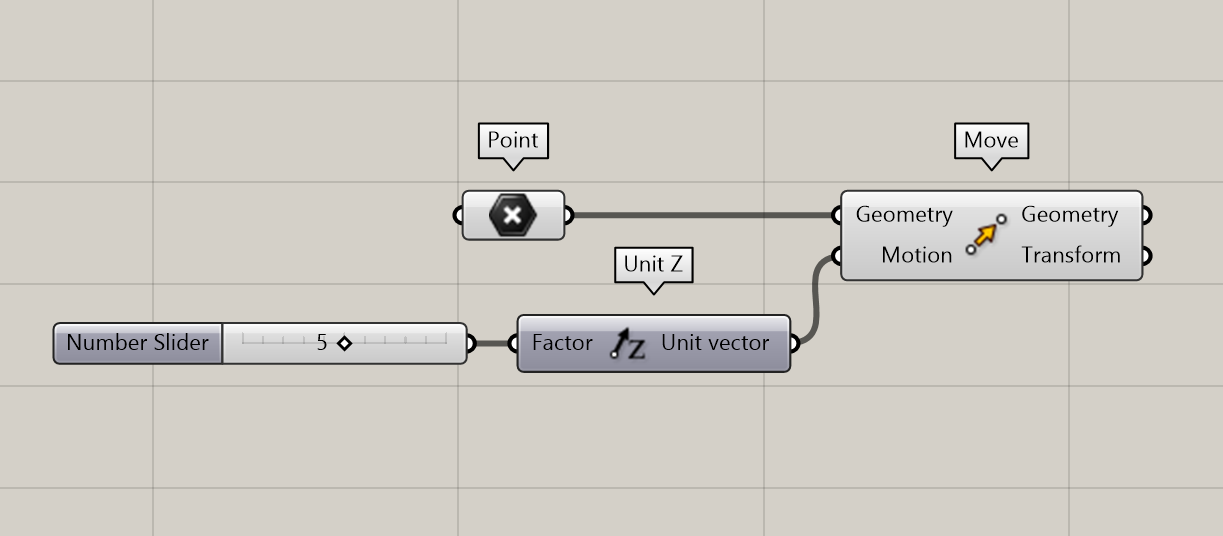Grasshopper
-
Intro
-
Tutorials
-
Useful links and readings
Information
| Last updated | November 27, 2024 |
Responsible
| Faculty |
Grasshopper 0/2
Grasshopper
Grasshopper is a graphical algorithm editor tightly integrated with Rhino’s 3D modeling tools.
For designers who are exploring new shapes using generative algorithms, Grasshopper is a graphical algorithm editor tightly integrated with Rhino’s 3D modeling tools. Unlike RhinoScript, Grasshopper requires no knowledge of programming or scripting, but still allows designers to build form generators from the simple to the awe-inspiring.
What is Grasshopper?

Grasshopper (GH) is a programming interface for designers. Instead of using programming languages, it uses what is called scripting. Scripting allows users to add components onto a canvas and connect them to create sequences of commands. Using simple blocks, a designer can easily create parametric designs. Grasshopper represents a way of thinking for design problems, a ‘method’ called Parametric or Associative these days. Simply, Grasshopper’s ease of use enables architects to use Parametric or Associative design without the need to be an expert in programming languages. Therefore architects can focus on the “why” instead of the “how”. Grasshopper is developed by McNeel and is built into Rhinoceros.
Basic understanding of Grasshopper

Grasshopper allows users to place blocks, called components, onto the Grasshopper canvas and connect them together forming a larger network, called a script. The canvas in Grasshopper is a visual representation of components used and their internal relation. The script is put together to create a series of commands that complete a logic or task, like creating a room with varying widths. Scripts in Grasshopper always work downstream and run sequentially from the first input(s).
The components are the building-blocks for your script. Each component executes specific commands. Many of the commands are similar to actions you can perform in Rhino, but other components also expand on the Rhino functionality. What makes Grasshopper useful is that it automatically executes the commands, allowing for the automation of tasks and quickly deriving design variations.
There are different types of components in Grasshopper panels. You can find them under ten different tabs called: Params, Maths, Set, Vector, Curve, Surface, Mesh, Intersect, Transform and Display. Each tab has multiple panels and different objects, and commands are sorted between these panels.
Components have a variety of functions like:
- creating geometry like lines and circles
- performing actions like move, scale, divide, and deform
- generating data or manipulating data
- representing rhino geometry
In addition to the components that come with the instillation of Grasshopper, more components can be added by installing various Grasshopper plug-ins. These are found on Food4Rhino.
To make a script, multiple components are placed on a canvas and connected to achieve the desired logic.
Each component consists of two or three elements:
- One or more inputs
- The action; what the component does with the input
- One or more outputs
The following is a quick example demonstrating a simple Grasshopper script. In the image, you can see a simple script that is moved a point 5 units in the Z direction by:

- Linking a point from Rhino using the Point component
- Creating a vector along the Z axis of length 5 units by connecting a number slider set to 5 to the Unit Z component
- Using the Move component with 2 inputs: the point and the vector
In the tutorials Chapter, you can find the Grasshopper tutorials. For tutorials that focus on a specific Grasshopper Plug-In, please visit the software page of that respective plug-in.
Grasshopper 1/2
Tutorialslink copied
Getting started
The following pages will give you a short overview of how Grasshopper works and teach you the basic principles to start working with Grasshopper.
Beginner
To get started with grasshopper, after reading the Getting Started chapter explanations, you can continue with one of the beginner tutorials.
Intermediate
Once you feel confident with beginner tutorials, it’s time to move on to the more intermediate tutorials.
Advanced
The advanced tutorials will bring your skills up and your projects to another level!
Expert
Grasshopper 2/2
Useful links and readingslink copied
The field of generative design is developing very quickly. If you are interested, there are many interesting blogs and websites you can check out:
- AAD_ Algorithms Aided Design:
- Parametric strategies using Grasshopper, an explanatory Grasshopper book written by Arturo Tedeschi. Available in several online webshops.
- Loan at TU Delft Library
- Get your own copy at Bol
- Essential Mathematics:
- Essential Mathematics for Computational Design introduces design professionals to foundation mathematical concepts that are necessary for effective development of computational methods for 3D modeling and computer graphics.
- Download from pdf Rhinoceros
- Generative Algorithms:
- Zubin Khabazia, a graduate student from EmTech, Architectural Association (AA), London, has published an on-line book of his design experiments in architecture and related fields in geometry.
- Download pdf directly
Other links
- Food4Rhino
- Collection of the most used Grasshopper and Rhino plugins.
- McNeel Forum McNeel Forums
- where you can ask questions and solve problems with other people all around the world
- @Hok TU Delft
- @Hok ICT support for student of TU Delft, including manuals about installing Rhino, Karamba and Grasshopper.
Write your feedback.
Write your feedback on "Grasshopper"".
If you're providing a specific feedback to a part of the chapter, mention which part (text, image, or video) that you have specific feedback for."Thank your for your feedback.
Your feedback has been submitted successfully and is now awaiting review. We appreciate your input and will ensure it aligns with our guidelines before it’s published.
